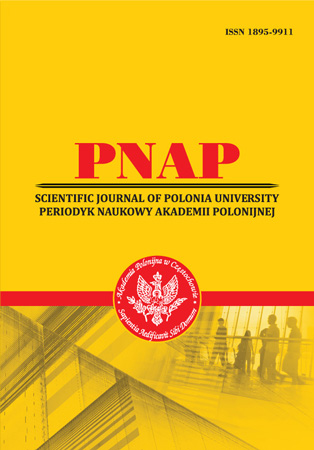FOLLOWING L&D TRENDS: CONTINUOUS LEARNING IN CANADA
Abstrakt
The article analyzes the best practices of building the culture of continuous learning in Canadian organizations through the prism of such global corporate Learning and Development trends as increasing investment into corporate learning, extensive use of technology, effective prediction, assessment and addressing skill gaps, especially in the area of soft skills development. As the Canadian authorities play a significant role in promoting the culture of continuous learning in organizations, the following aspects of their involvement are analyzed: recommendations of Canadian government on continuous learning within a company, predicting and addressing demands of the future in terms of emerging skills development, enabling access to education at all stages of person’s life. The article further dwells on two major challenges faced by companies in Canada due to technological disruption: keeping up with rapid pace of changes in terms of employees’ digital literacy and using technology effectively to build the culture of continuous learning. The issue of constant lack of time for a modern professional is also addressed. As companies strive to keep up with the pace of global changes, new employment opportunities are constantly created requiring professionals with diverse skillsets which might be currently in scarcity. A number of ongoing projects run by Canadian companies and authorities is analyzed to illustrate the best practices of building the culture of continuous learning to address the issue. Particular attention is paid to soft skills development.
Wykaz bibliografii
2. 2018 workplace learning report. The rise and responsibility of talent development in the new labor market. (2018). LinkedIn Learning. https://learning.linkedin.com/content/dam/me/business/en-us/amp/learning-solutions/images/workplace-learning-report-2019/pdf/workplace-learning-report-2019.pdf
3. Asliturk, E., Cameron, A., & Faisal, S. (2016). Skills in the digital economy: Where Canada stands and the way forward. Information and Communications Technology Council. http://www.ictc-ctic.ca/wp-content/uploads/2016/05/Skills-in-the-Digital-Economy-Where-Canada-Stands-and-the-Way-Forward-.pdf
4. Billett, S., Harteis, C., & Gruber, H. (Eds.). (2014). International handbook of research in professional and practice-based learning. Springer Netherlands. https://doi.org/10.1007/978-94-017-8902-8
5. Bridging the gap. What canadians told us about the skills revolution. (2019). RBC. https:// www.rbc.com/dms/enterprise/futurelaunch/_assets-custom/pdf/RBC-19-002-SolutionsWanted-04172019-Digital.pdf
6. Building a highly skilled and resilient Canadian workforce through the FutureSkills Lab. (2017). Advisory Council on Economic Growth, Canada. https://www.budget.gc.ca/aceg-ccce/pdf/skills-competences-eng.pdf
7. Future Skills Council. (2018). Employment and Social Development Canada. https:// www.canada.ca/en/employment-social-development/programs/future-skills/council.html
8. Canada’s innovation and skills plan. (2017). Canada. https://www.budget.gc.ca/2017/docs/ themes/Innovation_en.pdf
9. Cotsman, S., & Hall, C. (2018). Learning cultures lead the way: learning and development outlook – 14th edition. The Conference Board of Canada.
10. Developing Canada’s future workforce: A survey of large private-sector employers. (2016). Aon Hewitt. https://thebusinesscouncil.ca/wp-content/uploads/2016/03/Developing-Canadas-Future-Workforce.pdf
11. Digital IQ 2017–Canadian insights. (n.d.). PricewaterhouseCoopers Canada. Retrieved July 23, 2020, from https://www.pwc.com/ca/en/services/consulting/publications/digital-iq-survey-2017.html
12. Edwards, R. (2002). Changing places? Flexibility, lifelong learning and a learning society (1st ed.). Routledge. https://doi.org/10.4324/9780203132029
13. Garvin, D. A. (1993). Building a learning organization. Harvard Business Review, 71, 78–91.
14. Göschlberger, B., & Bruck, P. A. (2017). Gamification in mobile and workplace integrated microlearning. Proceedings of the 19th International Conference on Information Integration and Web-Based Applications & Services – IiWAS ’17, 545–552. https://doi.org/10.1145/3151759.3151795
15. Ho, M., Jones, M., Cole, M., & Robinson, S. (Eds.). (2018). Lifelong learning. The path to personal and organizational performance. Whitepaper. ASTD DBA Association for Talent Development (ATD); www.td.org/Store.
16. Ho, M., Jones, M., Robinson, S., & Moore, A. (Eds.). (2019). 2019 Global trends in talent development. Whitepaper. ASTD DBA Association for Talent Development (ATD); www.td.org/Store.
17. Humans Wanted: How Canadian youth can thrive in the age of disruption. (2018). RBC. https://www.rbc.com/dms/enterprise/futurelaunch/_assets-custom/pdf/RBC-Future-Skills-Report-FINAL-Singles.pdf
18. IMD World Talent Ranking 2019. (2019). IMD: Institute for Management Development.
19. Impact report. (2018). MaRS Discovery District. https://www.marsdd.com/wp-content/uploads/2018/09/MaRS_Impact_Report_2018.pdf
20. Increasing the return on talent development for Canadian companies. (2015). Accenture. https://thebusinesscouncil.ca/wp-content/uploads/2015/04/accenture-increasing-return-talent-development-canadian-companies.pdf
21. Knowles, M. S. (1975). Self-directed learning: A guide for learners and teachers. Association Press.
22. L&D from both sides of the table. 21 insights to maximize your L&D investment. (2018). Coursera for Business. https://pages.coursera-for-business.org/rs/748-MIV-116/images/Coursera%20Enterprise%20L&D%20from%20Both%20Sides%20of%20the%20Table%20ebook%20v01.30.pdf
23. Learning nation: Equipped Canada’s workforce with skills for the future. (2017). Advisory Council on Economic Growth, Canada. https://www.budget.gc.ca/aceg-ccce/pdf/learning-nation-eng.pdf
24. Lee, H., & Lee, M. (2018). Social learning constructs and employee learning performance in informal Web-based learning environments. Journal of Workplace Learning, 30(6), 394–414. https://doi.org/10.1108/JWL-11-2017-0101
25. Margol, E. G. (2017). Microlearning to boost the employee experience. Association for Talent Development.
26. Navigating change: 2018 Business Council Skills Survey. (2018). Morneau Sheppell. https://thebusinesscouncil.ca/wp-content/uploads/2018/04/Navigating-Change-2018-Skills-Survey-1.pdf
27. O’Grady, K., Deussing, M.-A., Scerbina, T., Fung, K., & Muhe, N. (2016). Measuring up: Canadian results of the OECD PISA study. The performance of Canada’s youth in science, reading, and mathematics. 2015 first results for Canadians aged 15. Council of Ministers of Education, Canada. http://deslibris.ca/ID/10065015
28. Scerbina, T., Sukovski, K., Duclos, É., Rainville, B., Santilli, D., Hango, D., Grenier, S., Greenberg, S., & Marmen, L. (2013). Skills in Canada: First results from the Programme for the International Assessment of Adult Competencies (PIAAC) (Catalogue No. 89-555-X). Statistics Canada. https://www.deslibris.ca/ID/240077
29. Skills for an automated future. (2018). The Canadian Chamber of Commerce. http://www.chamber.ca/media/blog/180323-skills-for-an-automated-future/
30. Tannenbaum, S. I. (1997). Enhancing continuous learning: Diagnostic findings from multiple companies. Human Resource Management, 36(4), 437–452. https://doi.org/10.1002/(SICI)1099-050X(199724)36:4<437::AID-HRM7>3.0.CO;2-W
31. What employers can do to encourage their workers to retrain. (2017, January 12). The Economist. https://www.economist.com/special-report/2017/01/12/what-employers-can-do-to-encourage-their-workers-to-retrain
Abstract views: 1716 PDF Downloads: 556







